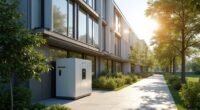Solar shingles are reshaping rooftops by seamlessly combining style with sustainability—think of them as the superheroes of roofing! With a projected 18% adoption rate in the U.S. by 2032, homeowners are catching on to their ability to generate electricity without sacrificing aesthetics. While they operate at 14-18% efficiency, advancements are closing the gap. Attractive and eco-friendly, these innovative shingles not only brighten roofs but also contribute to a greener planet, hinting at an exciting future for energy solutions.
The Rise of Solar Shingles: A Sustainable Roofing Solution
As the sun rises higher in the sky, it casts a new light on the world of roofing, where solar shingles are quickly making a name for themselves. These innovative wonders blend traditional roofing materials with photovoltaic technology, allowing homeowners to harness the sun’s energy while keeping their homes stylish. Think of them as the Swiss Army knife of roofing—serving both as a protective roof and a power source.
Solar shingles utilize semiconductor materials to convert sunlight into electricity, all while remaining weatherproof against wind, rain, and snow. Unlike clunky solar panels that sit atop roofs like an unwelcome guest, these shingles seamlessly integrate into the roof design, offering an aesthetic charm that won’t ruin your home’s curb appeal. These systems represent a significant advancement in renewable energy sources that homeowners can implement without sacrificing their property’s appearance.
With options ranging from monocrystalline to thin-film designs, they come in various wattages, making it easier for homeowners to find the perfect fit for their energy needs. However, it is essential to recognize that solar shingles operate at a lower efficiency—around 14-18%—compared to their panel counterparts. This is largely due to their fixed placement, which can limit sunlight exposure. Higher efficiency ratings are found in some models, like the Timberline Solar by GAF Energy, which boasts a maximum efficiency rating of 23%.
Traditional solar panels typically recoup costs within 5-8 years, whereas solar shingles usually reach their break-even point in 8-12 years. But don’t fret! Advanced technologies are continually closing this performance gap, making solar shingles a more viable option for energy production. The upfront cost of solar shingles can be intimidating, running between $63,000 to $75,000 for installation.
But when you consider their dual-purpose nature, the long-term savings on electricity bills, and potential tax incentives, they start to look like a savvy investment. Plus, they help reduce greenhouse gas emissions and promote energy independence by allowing homeowners to generate their own electricity.
In the grand game of energy, solar shingles are not just a trend; they represent a growing movement toward sustainability and efficiency. With an estimated 18% adoption rate in the U.S. by 2032, the future of roofing looks bright—literally!









